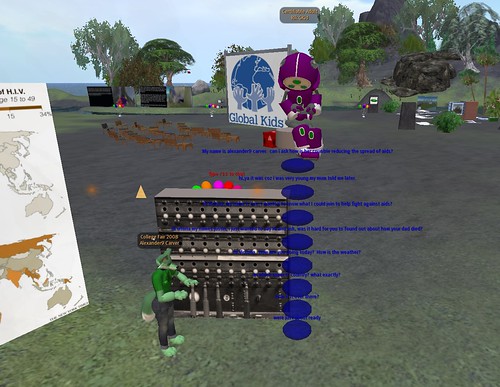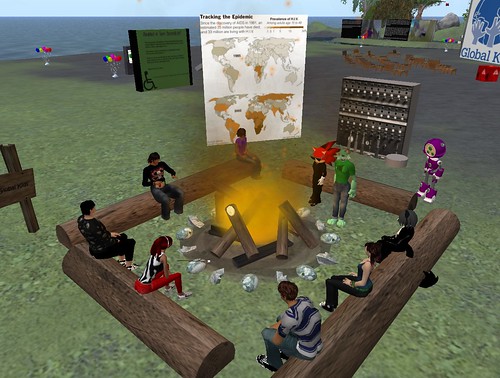
The screenshot here is kind of hard to parse so let me describe it. A young person (represented by the green furry) in Teen Second Life is composing a text message to send to another teen in Uganda that she will recieve on her cell phone as an SMS message. Meanwhile my avatar (the purple robot) sits atop the chat history represented by floating text and blue bubbles that rise higher as each new message is sent. This remarkable exchange from the virtual world to a regular cell phone is made possible by the grey device behind the bubbles, a tool we call "Switchboard."
A little background after the jump…
Today Shawna and I organized a very special workshop and discussion on
AIDS in Africa. About a dozen teens converged on Global Kids Island in Teen Second Life to participate in the event.
To frame the issue, Shawna gave a brief overview of the impact of AIDS worldwide and in Africa, using text chat and a couple of maps showing the most effected regions of the world. Then in true Global Kids fashion, she had the teens break up into teams and role play as different countries and describe the efforts being done in different parts of the world to fight the pandemic, including abstinence campaigns, free condom distribution, and education about safe sex practices.
To give the issue a more human face, we introduced the teens to Victoria, a 17-year old girl living in Kampala, Uganda who lost her father to AIDS when she was very little and whose mother is bedridden with the disease as well. Normally Victoria would not be able to communicate with these tech-enabled teens. So we employed a new tool that we had developed called Switchboard that can exchange text messages between a standard cell phone anywhere in the world and avatars in Second Life.
The teens at the workshop were eager to ask Victoria questions about her life, from how she coped with losing her father to what she thinks should be done to stop the spread of AIDS in Uganda. Victoria explained that for her educating young people was very important as well as helping those who had the disease not to spread it to others. She hoped that teens might support programs that educate about AIDS financially and that she would email some possible programs they could donate to.
It was a short and terse conversation, given the bandwidth limitations of SMS text messaging to and from Africa. But hopefully it helped frame the issue more personally for our teens and help Victoria to know that there were others outside of Uganda who knew about her story and wanted to help fight AIDS worldwide.
This is just the first public trial of this innovative mash-up technology. Once we work out the kinks, we plan to release the scripts and web moderation system behind it for others to use in their own work.
For now, I’m just relieved that it actually worked!

This is fantastic. I absolutely love the idea not only of being able to communicate from within SL to those outside, but the fact that these students were able to have a conversation with someone living with the reality of what these diseases can do is such a powerful thing.
I can’t wait to hear/learn more about these sorts of mashups and what we can do with them. Thanks for sharing!
-Shannon
(Micala Lumiere in SL)
Wonderful! We look forward to the application of this technology in various forms in Africa. Thank you!